|

Last Days:
Famines
and floods will increase in many areas. Diseases and epidemics will become worse.
From: jagbir singh <www.adishakti.org@gmail.com>
Date: Sat Jan 1, 2005 3:56 pm
Subject: Re: Shri Mataji: "It means the Last
Judgment has begun with full force."
—- In
shriadishakti@yahoogroups.com, "jagbir singh" <adishakti_org@y...>
wrote:
>
> Famines and floods will increase in many areas. Diseases
and
> epidemics will become worse.
>
Part I: The Century's
Worst Weather
Posted on Fri, 08 Oct 2004 19:29:35
GMT
 Written
by Cynthia
Long, Staff Writer,
DisasterRelief.org Written
by Cynthia
Long, Staff Writer,
DisasterRelief.org
After studying weather records back
to 1900, the United States government's leading scientists
and climatologists compiled a list of the world's top
weather, water and climate events of the 20th century.
Dozens of National Oceanic and Atmospheric Association (NOAA)
experts contributed to a U.S. and a global list of wild
weather incidents that were noted for their atmospheric
marvel or impact on human life. From floods, typhoons,
hurricanes and droughts to heat waves, tornadoes, winter
storms and blizzards, the weird weather was measured by the
event's magnitude, meteorological uniqueness, economic
impact and death toll.
"The lists demonstrate the wide
range of weather calamities that impact much of the world's
public, and supports the notion that our never-ending search
to completely understand these powerful climate and weather
events will remain somewhat elusive," said D. James Baker,
NOAA Administrator. "The listing commemorates the century's
weather for its intensity, scope and impact, but it is by no
means an exhaustive list."
|

From cyclones to
tornadoes, NOAA scientists list some of the century's
wildest weather. |
As the
lists indicate, the world has been dealt a host of wild
weather cards over the past 100 years, but has witnessed
in recent time some of the century's most ferocious and
destructive events. The climate is changing, the experts
said, and pollutants in the upper atmosphere are playing
a role in that change. |
Part II of The Century's Worst
Weather will explore how human activity and the effects
of global warming are impacting worldwide weather, and what
we can expect from those changes in the future.
The lists of events also form a
historical road map of progress in weather, water and
climate forecasting, according to John J. Kelley, Jr.,
Director of NOAA's National Weather Service. "They are both
a reminder of our vulnerability to the atmosphere and a
testatment to the [forecasting] advances we have made," he
said. "These events are the big ones that have helped shaped
America's relationship with the atmosphere, and have helped
further our understanding of Mother Nature." Part III of the
Century's Worst Weather will examine some of the
advancements in forecasting that weather experts have made
over the past 100 years.
Following is NOAA's rundown of the
century's worst weather:
International Worst
Weather Events of the 20th Century
Drought and famine in China in
1907, toll estimated at 24 million. Millions dead in other
drought-related famines in 1928-30, 1936 and 1941-42.
Drought in the Ukraine and Volga
region of the Soviet Union in 1921-22, deaths estimated at
250,000 to 5 million.
Indian drought of 1965-67,
estimates of dead at 1.5 million. In 1900, drought in India
blamed for 250,000 to 3 million deaths.
|
Yangtze
River flood, China, 1931, 3.7 million killed due to
flooding and subsequent disease and starvation.
Sahel drought in
Africa in 1972-75, with estimates of dead at 600,000.
|

Yearly monsoons swell
China's Yangtzee River, causing severe flooding that
destroys homes and lives. |
Bangladesh cyclone in 1970, with
300,000 to 500,000 dead in wind and storm surge.
Bangladesh cyclone in 1991, with
138,000 killed.
Flooding in Vietnam in 1971, with
100,000 killed.
|

The floods of
Hurricane Mitch swamped four countries in Central
America, killing about 11,000 people. |
Hurricane Mitch in Central America in 1998, with an
estimated 11,000 dead, the region's greatest hurricane
loss since 1780.
Great Iran flood in
1954, with more than 10,000 dead. |
Typhoon Thelma in 1991 in the
Philippines, with 6,000 fatalities.
Typhoon Vera in Japan in 1958, with
5,000 dead.
Great Smog of London in 1952, 4,000
deaths linked to the smog, that many others to related
causes.
Iran blizzard of 1972, with about
4,000 people dead.
Violent winter storms along the
coasts of northern Europe, including the Netherlands and
United Kingdom, in 1965, with 2,000 lives lost.
United States Worst Weather of the Century
|
Galveston Hurricane, 1900, a 20-foot storm surge swept
over Galveston Island and killed an estimated 8,000
people, the deadliest natural disaster in U.S. history.
|

Powerful winds and
storm surge from the Galveston Hurricane flattened
buildings across the Texas island. |
Dust Bowl of the 1930s, when
drought swept the Great Plains and plunged thousands into
poverty as farmers abandoned their land to seek better lives
elsewhere.
Tornado outbreak in 1974, when 148
tornadoes swept through the country from the Great Lakes to
Alabama and Mississippi and killed 315 people.
Hurricane Camille in 1969 claimed
256 lives.
Great Midwest Flood of 1993, the
costliest flood in U.S. history, claimed 48 lives and caused
$18 billion in damage.
El Nino
episodes of 1982-83 and 1997-98 caused storms that battered
the West Coast and set rainfall records in the Southeast.
Hurricane Andrew in 1992, which
caused 23 deaths and $25 billion in damage in Florida and
Louisiana.
|
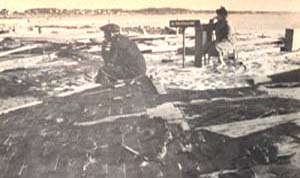
A New England husband
and wife look out over their leveled home and community
after the 1938 hurricane. |
|
New England hurricane in
1938, with 600 fatalities and millions in damage from New
York to Boston.
Winter superstorm of 1993,
which battered the eastern seaboard and claimed 79 lives.
Tristate tornado of 1925,
which killed 695 in Missouri, Illinois and Indiana.
Oklahoma-Kansas tornado outbreak in
1999, with more than 44 dead.
Great Okeechobee flood and
hurricane in 1928, which killed 1,836.
Storm of the Century, 1950, brought
snow and hurricane-force winds to 22 states and claimed 383
lives.
Florida Keys Hurricane, also known
as the Labor Day Hurricane, killed more than 400 in 1935.
New England blizzard of 1978
paralyzed New England for a week.
Part II: The Century's
Worst Weather
Posted on Fri, 08 Oct 2004 19:29:37
GMT
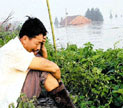 Written
by
Stephanie Kriner, Staff Writer,
DisasterRelief.org Written
by
Stephanie Kriner, Staff Writer,
DisasterRelief.org
When the floods approach, like
clockwork Vietnamese families string their most valuable
possessions by ropes and stow stacks of rice seed — intended
for the winter crop plantings — in the rafters. Then they
brace for the worst. During good years, the waters reach to
just past their ankles. In bad years, their flimsy bamboo
homes are washed away and their rice paddy fields are
destroyed. Whatever the damage, the Vietnamese have learned
to wring themselves out and start over, year after year.
But following some of the worst
flooding to hit the country in the 20th Century last
November and December, Vietnam's top leaders are determined
to find new ways to deal with the floods. "We need to find
ways to coexist in harmony with floods and minimize the
impacts of natural disasters," Foreign Minister Nguyen Manh
Cam said as he pleaded with international donors for
long-term disaster assistance during an annual meeting last
December.
Indeed, in Vietnam and around the
world, governments and relief organizations are searching
for ways to "coexist in harmnony" with nature. But with each
staggering death toll after increasingly catastrophic
disasters, evidence mounts that the intensity and frequency
of natural disasters will increase in the 21st Century.
"There are more people at risk than ever before," said Tom
Ross, a meteorologist with the National Climate Data Center.
Weather and relief experts blame the unsettling trend on
population growth and global climate change. As more and
more people crowd into cities or along coasts, the potential
for massive death tolls will increase. Further, some experts
predict that drastic shifts in the climate could lead to
more droughts, floods and hurricanes than ever before.
|
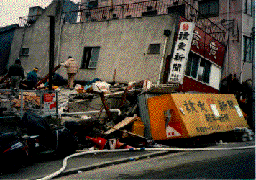
The 1995 earthquake that
struck Kobe, Japan, revealed the country's strong
vulnerability to its seismic land.
|
Before Vietnam's latest round of flooding, which killed
more than 700 people and set back development of Central
Vietnam by a decade, the International Federation of Red
Cross and Red Crescent Societies (IFRC) had already
begun a program to better prepare the Vietnamese for the
yearly deluge. The international relief movement
provided some 2,450 families with house-strengthening
kits. All but one withstood the subsequent flooding.
|
Around the globe, disaster-prone
nations have made similar realizations to Vietnam's. In
Venezuela, President Hugo Chavez has ordered the demolition
of homes in areas devastated by recent mudslides that left
as many as 50,000 people dead. To avert another disaster,
Chavez will move thousands to the country's sparsely
populated interior. In Turkey, where an Aug. 17, 1999,
earthquake killed about 17,000 people, contractors have come
under intense criticism for building unstable structures in
the country's quake-prone industrialized region. More
stringent building codes will be used during reconstruction.
|
Population Growth Puts More People at Risk
Between 1990 and 1995,
the cities of the developing world grew by 263 million
people — the equivalent of another Los Angeles or
Shanghai forming every three months, according to a
Worldwatch Institutes report. "Population increases in
developing-country cities will continue to be the
distinguishing demographic trend of the next century,"
the report stated. |
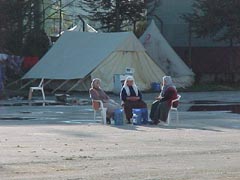
Following an Aug. 17
earthquake, thousands of Turkey's homeless still live
outdoors. |
As a result, natural disasters also
will continue to put more and more people at risk.
Throughout the 20th Century, and indeed over the past few
years, the world saw the devastating effects that natural
disasters have on heavily populated areas. From Hurricane
Mitch, which, in October of 1998, killed 10,000 people in
Central America's poorest slums to the Indian cyclone that
hit the coastal state of Orissa last fall, killing some
10,000 people and destroying 1 million homes.
"One of the troubling factors is
that more and more people are living in less and less space
... Towns and big cities no longer have the space to expand
and people are putting their homes in precarious places,"
said Martin Perret, who has worked for the Red Cross for
nearly 25 years.
But despite the examples that these
disaster-ravaged cities provide, the world's most populated
urban centers continue to grow. Tokyo's population
skyrocketed from 1.5 million people in 1900 to 28 million
people today. The sprawling city sits on a fault line that
seismologists warn could rupture at any time.
But most of the world's biggest
cities are in countries far poorer than Japan, places where
people already are living in wretched conditions. "At least
220 million people in cities of the developing world lack
clean drinking water, and 420 million do not have access to
the simplest latrines," according to Worldwatch. The poor
generally live in unstable homes and are forced to crowd
into hazardous areas. When a natural or man-made disaster
hits, the death toll can be astronomical. Thousands lose
their homes and meager belongings, and the poor descend
deeper into poverty.
|
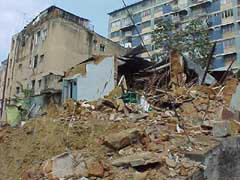
Overpopulated cities are
becoming bigger targets for natural disasters. |
Could Climate Change Trigger Even More Disasters?
By the third decade of
the 21st Century global climate change will become
increasingly obvious and ominous. In China, people will
begin to notice that the winters have grown warmer.
Increased rainfall will deliver even more flooding in
coastal provinces and inland droughts will lead to more
famines, according to the Global Scenario Group, an
international consortium addressing long-range
environmental and development possibilities.
|
It's a grim outlook for the country
that lost more lives to natural disasters than any other
nation during the 20th Century. In the 1900s, China, the
most populated country in the world, also had the most
deadly disasters — a drought-related famine took the lives
of more than 30 million people and a Yangtze River flood
resulted in 3.7 million deaths from disease, starvation and
drowning in the summer of 1931.
In China and around the globe, the
next 1,000 years may only get worse, according to some
meteorologists. Without action to cut greenhouse gas
emissions, the climate of the coming millennium will get
warmer, and average global temperatures may rise 10 degrees
Fahrenheit by 2200. However, immediate action to halt global
warming could result in an increase of no more than 3
degrees Fahrenheit, according to the Environmental Defense
Fund (EDF).
|
Experts have warned that climate change could result in
massive droughts, famines and floods throughout the
world. But without a clear vision of what the human race
will do to stop global warming, meteorologists and
environmentalists say that the future looks
questionable. "Humanity is creating a new climate for
the new millennium. Once this climate change occurs,
there's no going back," said Dr. Michael Oppenheimer,
EDF chief scientist. "Actions taken now to cut
greenhouse-gas pollution will determine if adjustment to
future climate will be manageable or impossible."
|

The
Red Cross helps disaster-prone regions throughout the
world prepare for natural disasters. |
The world has limited time to act,
experts say. Climate now is changing faster than ever, said
D. James Baker, who heads the National Oceanic and
Atmospheric Administration (NOAA). Global temperatures for
1999 were expected to finish the year as the second warmest
year on record since 1900, NOAA said. "The new data, the
modeling results, and what we know about how the system
works is even stronger in pointing toward the fact that we
are seeing global warming and it is part of the overall
climate change" Baker said.
Related Stories
30 Years Later, Camille's Legend Remains Firmly Etched in
Gulf Coast Memory—August 16,
1999
International Red Cross Predicts More Global 'Super
Disasters'—June 24, 1999
The Storm That Changed America: The Galveston Hurricane of
1900—August 13, 1998
Death Toll From China Floods Tops 2,000—240 Million
Affected—August 6, 1998
Global warming 'has helped
spread disease'
Daily Telegraph, 19 February 2000
Global warming has increased disease across the planet, the
association was told yesterday.
Prof David Pimentel said that global warming would create a
favourable climate for disease-causing organisms and
food-plant pests and "a much more challenging planet for
humans struggling to survive".
Prof Pimentel, an ecologist at Cornell University said:
"Right now the evidence of significant global climate change
is minimal, but there are already noticeable increases in
human diseases worldwide. We're seeing the first signs that
global climate change can influence the incidences of human
disease. This change, combined with population growth and
environmental degradation, will probably intensify world
malnutrition and increases in other diseases as well."
He pointed to various ominous trends: Today, infectious
disease causes about 37 per cent of all deaths worldwide,
but the estimated number of deaths due to a variety of
environmental factors is higher and still growing.
Environmental diseases were attributed especially to organic
and chemical pollutants, including smoke from various
sources such tobacco and wood fuels.
Prof Pimentel said more than three billion people are
malnourished, the most ever, and that number increases every
year. Malnutrition increases susceptibility to infectious
and environmental diseases, such as diarrhoea and
pollution-related illnesses. The projected increase in
population in the next 50 years will exacerbate the spread
of disease globally.
Densely crowded urban environments, especially those without
adequate sanitation and nutrition, should cause great
concern because they are sources of disease epidemics,
including dengue fever, spread by the Aedes aegypti
mosquito. Global warming would encourage this mosquito and
others to spread north from the tropics, transporting dengue
and other diseases.
Waterborne diseases, which already account for nine out of
10 deaths from infectious disease in developing countries,
will become more prevalent in a warmer, more polluted and
crowded planet. For example, only eight of India's 3,120
towns and cities have full waste water treatment facilities.
Air pollutants adversely affect the health of more than four
billion people worldwide, and air quality in many places is
getting worse. The number of cars worldwide is growing about
at a rate three times faster than the world population.
Meanwhile, an expanding world population is burning more
fossil fuels for both domestic and industrial purposes.
About four billion people in developing countries who cook
with wood and coal over open fires suffer continuous
exposure to smoke. Wood smoke is estimated to cause the
death of four million children a year.
Malnourished people are increasingly susceptible to
infectious and environmental diseases. Increasing global
climate change will result in a net loss of food. Prof
Pimentel said: "Although there may be some benefits in crop
production from warmer climates, these beneficial effects
will be more than offset by the projected decline in
rainfall in critical crop-growing regions like the American
corn belt."
Crop losses from pest insects, plant diseases and weeds will
increase in a warmer climate, Prof Pimentel suggested.
Insect pests, plant pathogens and weeds already cause the
loss of more than 40 per cent of the world's food, despite
the application of £5 billion of pesticides each year.
Global warming 'has helped spread disease'
Daily Telegraph
'Billions' affected by disasters
Monday, 17 January, 2005, 17:05 GMT

Millions have been affected by the
Indian Ocean tsunami
|
At least 2.5 billion people have been affected by
natural disasters over the past 10 years - an increase of
60% over the previous decade, the UN says.
More than 478,000 people were killed by disasters such as
earthquakes, floods and hurricanes, from 1994 to 2003.
The most vulnerable people are those living in developing
nations, it says.
'Billions' affected by disasters
BBC
|